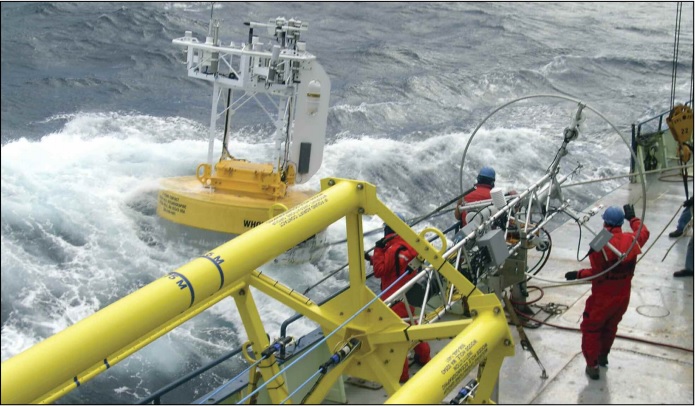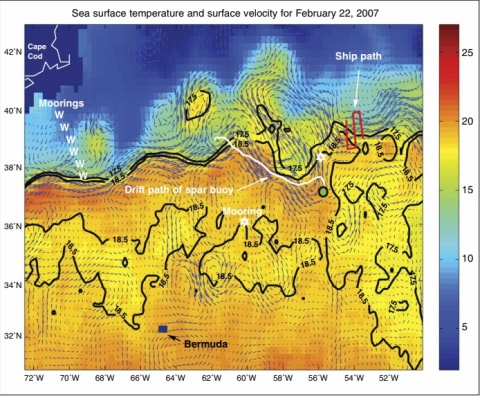On February 24, 2007, a storm hit the Research Vessel Knorr 1,200 kilometers (650 nautical miles) off the coast of Bermuda. Below decks, the crew listened as the fifty-foot waves and hurricane-force winds slammed into the ship. On the deck, strapped down with fourteen cargo straps, a fifty-foot-long instrument lay awash. Oceanographers aboard the ship had been using the instrument, called a spar buoy, to take measurements in the storm-pounded Northern Atlantic.
Terry Joyce, an oceanographer with the Woods Hole Oceanographic Institution, was aboard the ship during the cruise. He said, “During the night, as we limped toward Bermuda, we took a big wave over the bow and had water up on the bridge. The wave destroyed the spar buoy, which we’d gone to such effort to recover just the day before so it wouldn’t get damaged at sea.” The wave snapped seven of the cargo straps and swept parts of the buoy overboard; heavy battery cases rolled around on deck threatening to short out and spark a fire. The crew spent much of the night working to secure the mess while the storm continued to toss the ship. “When we got to Bermuda, we realized that there was no way to bring the Humpty Dumpty buoy back to life,” he said. “We knew we’d have to write it off and continue the cruise without it.”
So why would Joyce join other oceanographers and crew members aboard a ship purposefully bound for the Gulf Stream, an ocean current associated with dangerous winter storms? Joyce was part of a three-year, multi-institutional effort that included fifteen Principal Investigators, five research cruises, and both satellite and in situ data. The goal: to improve our understanding of Earth’s climate by studying the interaction between our planet’s ocean currents below and its atmosphere above.
Tracking a layer of slow-changing water
Before the storm destroyed the spar buoy, it was one of several key research tools for the crew aboard the R/V Knorr. Its downward end could probe into the ocean waters for conductivity, temperature, depth measurements, and surface wave height and direction; its skyward end could provide meteorological information like temperature, humidity, winds, and radiation. Joyce said, “It was like spawning a second vessel that stayed in just the right spot, drifting with the flow, while the ship went off and took additional measurements. It was a fantastic device for measuring air-sea exchange.”
Joyce and the other scientists aboard the R/V Knorr were interested in air-sea exchange because that interaction helps drive global climate. To get measurements of the heat hand off between oceans and atmosphere, the science team wanted to be sure that they deployed the spar buoy, as well as dozens of other instruments, where a specific layer of ocean water in the Gulf Stream was actively forming. This layer, loosely referred to as subtropical mode water, forms during the winter when the waters of the Gulf Stream flow to thirty degrees North Latitude and hand heat off to the atmosphere. The mode water is a large mass—sometimes 500 to 800 meters (1,640 to 2,625 feet) thick—that is consistently 18 degrees Celsius (64 degrees Fahrenheit). University of Washington oceanographer Kathie Kelly said, “The mode water is so thick, and is such a heat reservoir, that it takes years and years to change it.” Kelly continued, “Mode water is considered the long-term memory of the climate system.
The layer of water is so very deep, it’s almost impossible for the atmosphere to warm it and almost impossible to cool it. So it stabilizes the climate system and provides a long-term signal for climate.” Joyce agreed, saying, “The connection between the Gulf Stream, mode water formation, and winter storms is fundamental to the way climate on Earth works—but that connection isn’t really very well understood. That’s what we’re hoping to learn by studying mode water.” But to study the thick layer of water, the ship’s crew first had to find it.
Satellite data comes onboard
How did the crew aboard the R/V Knorr know exactly where to find the elusive mode water to deploy their instruments? Suzanne Dickinson, Kelly’s colleague and fellow oceanographer, worked closely with the crew while she stayed warm and dry on land. She said, “During the cruises, I uploaded daily satellite maps, based on sea surface temperature, to the ship.” Sea surface temperatures helped the shipboard scientists find the eighteen-degree water because it forms when the atmosphere strips off the overlying warmer water through heat exchange, allowing the cooler water to appear at the surface. The satellite data they used came from the Advanced Microwave Scanning Radiometer for Earth Observing System (AMSR-E), which flies on the NASA Aqua satellite. AMSR-E is a passive microwave instrument, so it was able to see through the winter clouds and provide data even during the all-too-frequent winter storms.
Dickinson retrieved the sea surface temperature data through a NASA project called “Distributed Information Services: Climate/Ocean Products and Visualization for Earth Research,” or DISCOVER. The goal of DISCOVER is to provide accurate long-term climate records and near-real-time ocean data products for scientists. Frank Wentz of Remote Sensing Systems, Inc., leads the DISCOVER team; NASA's Global Hydrology Resource Center Distributed Active Archive Center (GHRC DAAC) hosts the data for distribution in easy-to-use formats.
Joyce said, “The remote sensing information was invaluable. We’d wait for it daily and download it around two in the afternoon. We were working twelve-hour shifts day and night on the ship, so we tried to have a clear plan before we turned it over to the next shift.” By studying the broad coverage of the satellite maps, the crew was able to sail the ship to areas where mode water was forming to deploy their instruments.
Dickinson said, “In addition to the sea surface temperature data, we also sent QuikSCAT wind data, which helped the crew see what weather was coming, and altimeter data, which helped indicate currents.”
Gathering three types of data from various sources for five cruises spanning three years was not a simple task. Dickinson said, “Near-real-time data streaming doesn’t just happen all the time. Sometimes I’d look for the data and it wasn’t there—and I’d have to work with the DISCOVER team to figure out the problem and how to fix it.” Kelly added, “And the thing about cruises is that it’s not okay if they miss a couple of days of data. The DISCOVER team and Suzanne were tag-teaming every day to make sure the crew had a map each afternoon. Ocean-going scientists don’t want to go out without their satellite maps—it would be like taking a cross-country tour without your road atlas or GPS.”
Understanding the ocean’s memory
Joyce, Kelly, Dickinson, and the other scientists involved in the study, called the Climate Variability and Predictability Mode Water Dynamics Experiment (CLIMODE), hope that the years of work, the many stormy wintertime cruises, and the unique combination of satellite and shipboard data will ultimately improve our understanding of both mode water and climate on Earth.
Because of the ocean’s predilection for slow change, understanding the current state of mode water and how it may influence future climate are uppermost in the minds of oceanographers. Some oceanographers who study Greenland ice cores as a paleological record of climate have suggested that if global warming continues, we could see changes in ocean circulation that could cause abrupt or extreme changes in climate.
Joyce said, “But before we can understand how heat transport is going to evolve in a warming world, we have to understand how the basic system works: If you had more heat transported by the Gulf Stream, would that make it more stormy? Or would it change where the storms happen? And if you perturb the system, how would it react? Right now, we don’t know. But that’s what we’re hoping to learn.”
References
Kelly, K., R. Jones, and S. Dickinson. 2006. SST, winds, and air-sea fluxes in the Gulf Stream region in the first winter of CLIMODE. Eos, Transactions, American Geophysical Union 87(52), Fall Meeting Supplement, Abstract OS44A-02.
Peña-Molino, B., and T. Joyce. 2008. Variability in the slope water and its relation to the Gulf Stream path. Geophysical Research Letters 35, LO3606, doi:10.1029/2007GL032183.
Woods Hole Oceanographic Institute. The hunt for 18° water. http://www.whoi.edu/oceanus/viewArticle.do?id=11274
For more information
NASA Global Hydrology Resource Center Distributed Active Archive Center (GHRC DAAC)
NASA National Snow and Ice Data Center (NSIDC DAAC)
Climate Variability and Predictability (CLIVAR) Mode Water Dynamic Experiment (CLIMODE)
University of Washington Applied Physics Laboratory
Woods Hole Oceanographic Institution
| About the remote sensing data | |||
|---|---|---|---|
| Satellites | QuikSCAT | TOPEX/Poseidon/Jason-1 | Aqua |
| Sensors | SeaWinds scatterometer | Nadir-pointing radar altimeter | Advanced Microwave Scanning Radiometer for Earth Observing System (AMSR-E) |
| Data sets | QuikSCAT near-real-time ocean wind vectors | Sea surface height | Sea surface temperatures |
| Resolution | 25 kilometers | 0.0001° in latitude and 0.05° in longitude | 25 kilometer |
| Parameters | Wind vectors | Sea surface height | sea surface temperature |
| DAACs | NASA Physical Oceanography Distributed Active Archive Center (PO.DAAC) | NASA PO.DAAC | NASA National Snow and Ice Data Center DAAC (NSIDC DAAC) |

